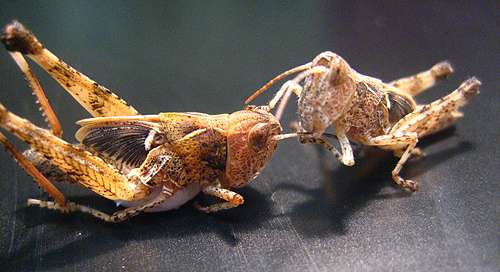From solo to sociable—how locusts try to avoid cannibalism

(Phys.org)—When people think of locusts they are likely to picture the swarms which affect the lives of one in ten people in the world through their harmful impact on agriculture.
But in fact locusts are both solitary and social animals, and new research by the University of Sydney and international researchers suggests cannibalism has played a crucial role in the evolution of this behavioural transformation.
Whether an individual locust becomes solitary or swarming depends on its experience of being crowded. Previously scientists at the University uncovered what triggers the change but the evolutionary advantage of locusts being in two forms remained unknown until this current research, recently published in Ecology Letters.
"Our work also found that once the locusts are on the march it requires a much greater reduction in population density to trigger a return to the solitary state than the increase in numbers which brings about their sociability and the creation of a swarm, with obvious implications for their management," said Professor Stephen Simpson, from the School of Biological Sciences.
Locusts live a solitary life, avoiding contact with each other when the density of their numbers is low in a given area. At the tipping point - when that density reaches a critical level - this repulsion declines and the locusts make a rapid transition to being 'gregarious' or attracted towards each other.
The ultimate result, if that behaviour continues, is a swarm which can contain millions of insects travelling thousands of kilometres while devastating vegetation and crops.
"While the locusts' change has been extensively studied, the ultimate driving factors have, until now, remained unclear," said Professor Simpson.
"By modelling the evolution of locusts' behaviour we discovered that the density-dependent change in their behaviour may be caused by trying to minimise the threat of cannibalism. Cannibalism is a common characteristic of all locusts, especially when they are deficient in protein."
In their solitary phase the locusts avoid each other entirely except when they are ready to mate. When their numbers increase however they become sociable and move away from locusts who approach them in order to avoid being eaten. But at the same time they are attracted to locusts moving away from them because of their general tendency to follow others.
This escape-pursuit behaviour results in individuals aligning the direction of their movement and the formation of large mobile bands or swarms.
"So, counter-intuitively, our modelling indicates that not one but both states - solitary and gregarious - are an outcome of trying to reduce the costs of cannibalism."
The implications of the research for controlling locusts is twofold. It emphasises that preventive measures need to take into account that the transition to 'gregariousness' may occur in local populations well before a swarm forms but is a useful alert.
"We also concluded that to control locust outbreaks after they occur the population densities must be reduced by substantially more than the levels at which the trigger to be gregarious, leading to the swarm, happen," said Professor Simpson.
"That is you need a bigger decrease in crowding to stimulate the move from gregarious to solitary than the increase in crowding which stimulates the move from solitary to gregarious."
More information: onlinelibrary.wiley.com/doi/10 … 012.01840.x/abstract
Journal information: Ecology Letters
Provided by University of Sydney


















